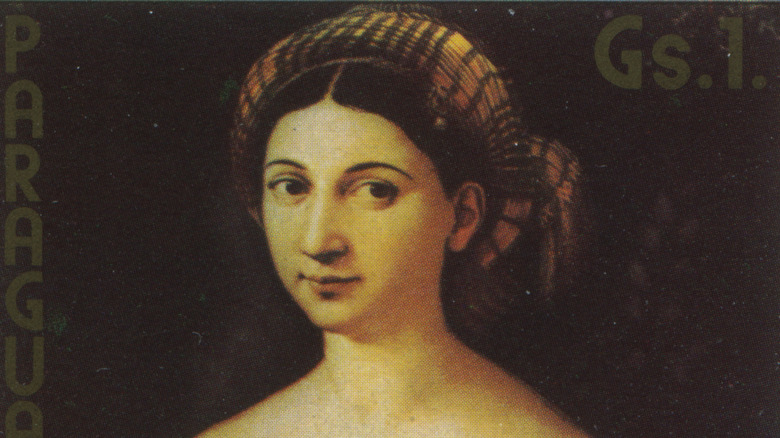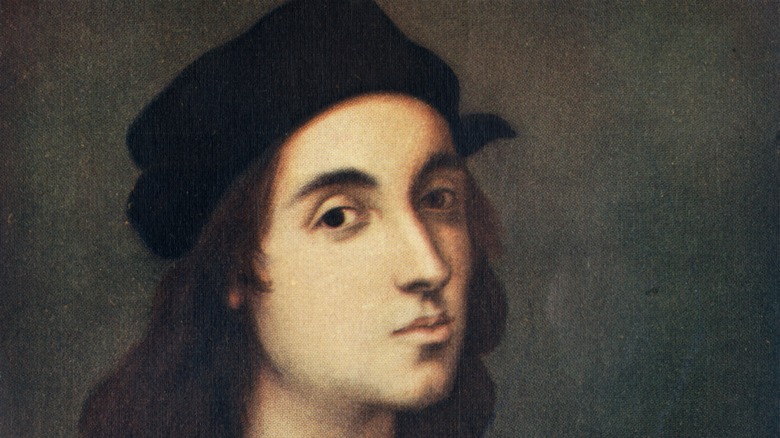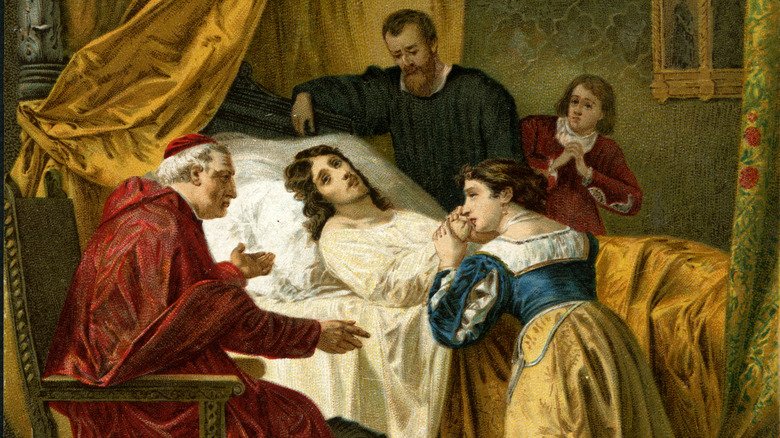The Frisky Fable Of Raphael's Death
The High Renaissance painter Raphael was prolific in more ways than one. Called a "master" artist at 17, his art rivals the other renaissance greats — his teachers Leonardo da Vinci and Michelangelo (via Britannica). Rafael is famous for his many depictions of the Madonna and child. He is just as well known for his numerous romantic affairs. Tragically, his fame and love life would factor in his early death.
Born in 1483, Raffaello Sanzio da Urbino is known for a life of abundant dalliances. However, the story of his relationship with Margherita Luti, a baker's daughter — nicknamed La Fornarina — has captured the imagination of writers and artists throughout the centuries, writes Wanted in Rome Magazine. Giorgio Vassari, a 16th-century art historian, wrote about how the two met. Reportedly, the painter stumbled upon Luti bathing in the river Tiber, though others claim he spotted her gazing out the window in Rome.
So passionate was Raphael's love of Luti that he — scandalously — insisted that she live with him in Rome while he completed his frescoes in the Vatican's papal apartments, says The Guardian. Luti is also the subject of Raphael's painting "La Fornarina" (above), on display at the Galleria Nazionale d'Arte Antica. Their affair inspired artists throughout the ages, including the 19th-Century painter Joseph Mallord William Turner, who depicts the two lovers looking out from the Vatican over Rome. Later, Picasso portrays the two lovers in an erotic series of sketches titled "Raphael et la Fornarina."
Mistruths led to a misdiagnosis
Raphael's death in 1520 has been misunderstood for centuries. Raphael's career was soaring at the time of his death (per Smithsonian). He and Michelangelo had the favor of Pope Julius II. They competed, producing works for the Vatican such as Raphael's "School of Athens" and Michelangelo's ceiling fresco in the Sistine Chapel. Sadly, Rafael's life and artistic career were cut short at age 37 (via Artnet News).
Until recently, many blamed Raphael's abundant sex life for his death, says Artnet News. This theory stems from Georgio Vasari's "The Lives of the Artists," a biography of many Rennaisance artists written several decades after Raphael's death, explains Smithsonian. Given the medical knowledge at the time, death by frequent lovemaking was rational. Too much of anything, including sex, was thought to create an imbalance in the four humors which determined a person's health.
In the centuries to follow, most continued the sex-related explanation, blaming Raphael's death on syphilis (per The Guardian). However, nothing quite added up. Raphael fell ill for 8-15 days before he died, depending on the source (via Smithsonian). Raphael (above, in a self-portrait) was coherent enough during his last days to put his affairs in order. He received the last rites, confessed his sins, set his studio in order, and secured money for Luti. He requested to be buried in the Pantheon and planned his own elaborate funeral (via Smithsonian). Now, researchers think they know the truth behind Raphael's death.
Death from too much sex?
The secrets surrounding Raphael's love life interfered with his treatment and hastened his death. In 2020, researchers from the University of Milano-Bicocca examined records of Raphael's life, illness, and treatment. They determined that the artist's death was not sex-related, but rather pulmonary disease, reports Artnet News. Pulmonary disease is an illness that affects the lungs and respiratory system like pneumonia, explains the National Cancer Institute.
The study published by the Italian Society of Internal Medicine suggests that Raphael's doctors actually sped up the artist's death by treating him with bloodletting and leeches. Michele Augusto Riva, a study author, told The Guardian that while bloodletting was a common practice at the time, doctors would not have used it for a respiratory illness.
Raphael hid the cause actual of his illness for fear of offending the pope, his patron. The pope had personally sent his top doctors to care for Raphael. Not wanting to scandalize his benefactor, Raphael kept mum about his sex life. His affairs required frequent nighttime outings in the cold, probably contributing to his sickness, says Artnet News. This lack of information muddled his treatment. So rather than too much sex causing the artist's death, negative attitudes toward sex prevented Raphael from getting the correct treatment, adding a new layer of tragedy to his story. His grave reads: "Here lies Raphael, by whom Nature herself feared to be outdone while he lived, and when he died, feared that she herself would die" (via Smithsonian).


